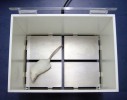Authors
M Boivin, J Deng, V Pfister et al
Lab
Institut de Génétique et de Biologie Moléculaire et Cellulaire (IGBMC), INSERM U 1258, CNRS UMR 7104, University of Strasbourg, 67404 Illkirch, France
Journal
Neuron
Abstract
Neuronal intranuclear inclusion disease (NIID) is a neurodegenerative disease characterized by the presence of intranuclear inclusions of unknown origin. NIID is caused by an expansion of GGC repeats in the 5_ UTR of the NOTCH2NLC (N2C) gene. We found that these repeats are embedded in a small upstream open reading frame (uORF) (uN2C), resulting in their translation into a polyglycine-containing protein, uN2CpolyG. This protein accumulates in intranuclear inclusions in cell and mouse models and in tissue samples of individuals with NIID. Furthermore, expression of uN2CpolyG in mice leads to locomotor alterations, neuronal cell loss, and premature death of the animals. These results suggest that translation of expanded GGC repeats into a novel and pathogenic polyglycine-containing protein underlies the presence of intranuclear inclusions and neurodegeneration in NIID.
BIOSEB Instruments Used:
Grip strength test (BIO-GS3),Rotarod (BX-ROD),Aron Test or Four Plates Test (LE830)

 Pain - Thermal Allodynia / Hyperalgesia
Pain - Thermal Allodynia / Hyperalgesia Pain - Spontaneous Pain - Postural Deficit
Pain - Spontaneous Pain - Postural Deficit Pain - Mechanical Allodynia / Hyperalgesia
Pain - Mechanical Allodynia / Hyperalgesia Learning/Memory - Attention - Addiction
Learning/Memory - Attention - Addiction Physiology & Respiratory Research
Physiology & Respiratory Research
 Pain
Pain Metabolism
Metabolism Motor control
Motor control Neurodegeneration
Neurodegeneration Cross-disciplinary subjects
Cross-disciplinary subjects Muscular system
Muscular system General activity
General activity Mood Disorders
Mood Disorders Other disorders
Other disorders Joints
Joints Central Nervous System (CNS)
Central Nervous System (CNS) Sensory system
Sensory system


